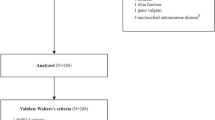Abstract
When children around 2 years of age show leg bowing and diseases are ruled out based on radiographic findings without conducting blood tests, they are classified as “physiologic” genu varum. Since whether or not physiologic genu varum is associated with bone metabolism is unclear, this study was conducted to clarify the association between genu varum and bone metabolism in children. Thirty-five pediatric patients with genu varm who visited our out-patient clinic were enrolled. While two of the 35 children had nutritional rickets, showing abnormalities on both blood test (ALP, ≥1000 IU/L; iPTH, >65 pg/mL and 25(OH)D, ≤20 ng/mL) and radiographs (such as cupping, fraying or splaying), five of 35 children showed abnormalities on blood tests but not radiographs. While metaphyseal-diaphyseal angle (MDA) correlated with serum 25-hydroxy vitamin D (r = −0.35, p = 0.04) and magnesium (r = −0.36, p = 0.04), MDA and femorotibial angle (FTA) correlated with alkaline phosphatase (r = 0.43, p = 0.01 and r = 0.51, p = 0.006, respectively). A ridge regression analysis adjusted for age and body mass index indicated that ALP was associated with MDA and FTA. A logistic regression analysis adjusted for age and BMI indicated that higher ALP influenced an MDA >11°, which indicates the risk for the progression of genu varum (odds ratio 1.002, 95% confidence interval 1.0003–1.003, p = 0.021). The higher ALP (+100 IU), the higher risk of an MDA >11° (odds ratio 1.22). In conclusion, genu varum is associated with the alkaline phosphatase level regardless of the presence of radiographic abnormalities in the growth plate in children.


Similar content being viewed by others

References
Herring JA (2008) Tachdjian’s Pediatric Orthopaedics From the Texas Scottish Rite Hospital for Children, 4th edition. Chapter 22 Disorders of the leg. Elsevier, Amsterdam, pp 973–974
Levine AM, Drennan JC, Contcut N (1982) Physiological Bowing and Tibia Vara. J Bone Jt Surg Am 64(8):1158–1163
Shinohara Y, Kamegaya M, Kuniyoshi K, Moriya H (2002) Natural history of infantile tibia vara. J Bone Jt Surg Br 84:263–268
Tanaka H, Ozono K, Kitanaka S, Tajima T, Hasegawa K, Hujiwara I, Michigami T, Minagawa M, Miyako K (2013) Clinical guide to the diagnosis of rickets and hypocalcemia due to vitamin D deficiency. Jpn Soc Pediatric Endocrinol
Montgomery CO, Young KL, Austen M, Jo CH, Blasier RD, Ilyas M (2010) Increased risk of Blount disease in obese children and adolescents with vitamin D deficiency. J Pediatr Orthop 30:879–882
Sabharwal S (2009) Blount disease. J Bone Jt Surg Am 91:1758–1776
Giwa OG, Anetor JI, Alonge TO, Agbedana EO (2004) Biochemical observations in Blount’s disease (infantile tibia vara). J Natl Med Assoc 96:1203–1207
Langenskiöld A (1981) Tibia vara: osteochondrosis deformans tibiae. Blount’s disease. Clin Orthop Relat Res 158:77–82
Davids JR, Huskamp M, Bagley AM (1996) A dynamic biomechanical analysis of the etiology of adolescent tibia vara. J Pediatr Orthop 16:461–468
Salenius P, Vankka E (1975) The development of the tibiofemoral angle in children. J Bone Jt Surg Am 57:259–261
Voloc A, Esterle L, Nguyen TM, Walrant-Debray O, Colofitchi A, Jehan F, Garabedian M (2005) High prevalence of genu varum/valgum in European children with low vitamin D status and insufficient dairy products/calcium intakes. Calcif Tissue Int 76:412–418
Schnitzler CM, Pettifor JM, Patel D, Mesquita JM, Moodley GP, Zachen D (1994) Metabolic bone disease in black teenagers with genu valgum or varum without radiologic rickets: a bone histomorphometric study. J Bone Miner Res 9:479–486
Blumenthal NC (1989) Mechanisms of inhibition of calcification. Clin Orthop Relat Res 247:279–289
Amizuka N, Li M, Kobayashi M, Hara K, Akahane S, Takeuchi K (2008) Vitamin K2, a gamma-carboxylating factor of gla-proteins, normalizes the bone crystal nucleation impaired by Mg-insufficiency. Histol Histopathol 23:1353–1366
Kobayashi M, Hara K, Akiyama Y (2004) Effects of vitamin K2 (menatetrenone) and alendronate on bone mineral density and bone strength in rats fed a low-magnesium diet. Bone 35:1136–1143
Atkins LA, McNaughton SA, Campbell KJ, Szymlek-Gay EA (2016) Iron intakes of Australian infants and toddlers: findings from the Melbourne Infant Feeding, Activity and Nutrition Trial (InFANT) Program. Br J Nutr 28:285–293
Zierk J, Arzideh F, Rechenauer T, Haeckel R, Rascher W, Metzler M, Rauh M (2015) Age- and sex-specific dynamics in 22 hematologic and biochemical analytes from birth to adolescence. Clin Chem 61:964–973
Taylor JA, Richter M, Done S, Feldman KW (2010) The utility of alkaline phosphatase measurement as a screening test for rickets in breast-fed infants and toddlers: a study from the Puget sound pediatric research network. Clin Pediatr 49:1103–1110
Joiner TA, Foster C, Shope T (2000) The many faces of vitamin D deficiency rickets. Pediatr Rev 21:296–302
Misra M, Pacaud D, Petryk A, Collett-Solberg PF, Kappy M (2008) Vitamin D deficiency in children and its management: review of current knowledge and recommendations. Pediatrics 122:398–417
Salenius P, Vankka E (1975) The development of the tibiofemoral angle in children. J Bone Jt Surg Am 57:259–261
Heath CH, Staheli LT (1993) Normal limits of knee angle in white children genu varum and genu valgum. J Pediatr Orthop 13:259–262
Greene WB (1993) Infantile tibia vara. J Bone Jt Surg Am 75:130–143
Acknowledgements
The authors thank all participating children and parents and all of the medical staff at the participating institutions for providing the clinical data.
Author information
Authors and Affiliations
Corresponding authors
Ethics declarations
Conflict of interest
The authors declare that they have no conflicts of interest.
About this article
Cite this article
Sakamoto, Y., Ishijima, M., Kinoshita, M. et al. Association between leg bowing and serum alkaline phosphatase level regardless of the presence of a radiographic growth plate abnormality in pediatric patients with genu varum. J Bone Miner Metab 36, 447–453 (2018). https://doi.org/10.1007/s00774-017-0851-6
Received:
Accepted:
Published:
Issue Date:
DOI: https://doi.org/10.1007/s00774-017-0851-6



